In the ever-evolving world of marketing,understanding the nuances of strategy is essential for businesses seeking to connect with their audience and flourish in their respective sectors. In the enlightening YouTube video titled “,” the discussion shines a spotlight on the critical components that form the backbone of effective marketing practices. While conventional marketing frameworks often focus on the classic 4Ps—Product, Price, Place, and Promotion—the service sector requires a more nuanced approach.Enter the 7Ps, which expand the landscape to include People, Process, and Physical Evidence, essential elements that substantially influence customer experience and satisfaction.
Join us as we explore these seven components in detail, unraveling how they intertwine to create robust marketing strategies that cater specifically to both products and services. Whether you’re a marketing guru or a budding entrepreneur, understanding these pillars can provide invaluable insights into how to engage and retain clients in today’s competitive marketplace. Let’s dive deep into this essential marketing framework and unlock the potential for success!
Table of Contents
- Exploring the Core Elements of the 7Ps Framework
- Delving into the Importance of People in Service Marketing
- Understanding the Impact of Process on Customer Experience
- Enhancing Physical Evidence to Build Trust and Credibility
- Q&A
- The Way Forward
Exploring the Core Elements of the 7Ps Framework

The 7Ps framework is essential for understanding the multi-faceted nature of marketing, especially when distinguishing between products and services. The first four elements—Product, Price, Place, and Promotion—are fundamental in establishing a visible market presence. However, in the service sector, three additional elements come into play: People, Process, and Physical Evidence. These elements broaden the horizon of marketing strategies, ensuring that both tangible and intangible aspects of services are emphasized. services frequently enough rely heavily on human interaction, making the quality and demeanor of People a critical component that directly influences customer satisfaction and loyalty.
Equally notable is the Process, which refers to the methods and procedures involved in delivering the service. A well-defined process promotes efficiency and consistency, enabling customers to have a seamless experience. Physical Evidence serves as a tangible representation of the service being offered. This can include the appearance of physical facilities, brochures, or even online interfaces that reassure customers of the service’s credibility. Understanding and strategically managing these seven elements allows businesses to create a cohesive and effective marketing strategy that resonates with their target audience.
Delving into the Importance of People in Service Marketing

In the realm of service marketing, the role of people cannot be overstated. Unlike tangible products,services hinge on human interaction,making customer experience a crucial element. Organizations must recognize that every individual involved—whether it’s a front-line employee, manager, or even a customer—contributes to shaping the service delivery and, inevitably, the brand’s reputation. Here are some key aspects highlighting the significance of people in service marketing:
- Customer Interaction: Employees are often the face of the brand, responsible for directly communicating with clients.
- Service Quality: Skilled personnel can elevate the quality of service, ultimately enhancing customer satisfaction.
- Emotional Connection: People create emotional ties that foster loyalty, transforming transactional interactions into meaningful relationships.
Furthermore, the integration of process and physical evidence into the service experience adds layers of complexity that are driven by people.The methods employed in delivering services, whether streamlined or innovative, rely heavily on the competencies of the staff executing them. Additionally, physical evidence—ranging from the ambiance of a service habitat to the branding elements—serves as a tangible reminder of the service experience. The interplay between these elements is crucial for comprehensively engaging customers. Consider the following table that summarizes the relationship between people, process, and physical evidence:
| Element | Role | Impact on Services |
|---|---|---|
| People | Agents of service delivery | Enhance customer satisfaction |
| Process | Outline the service flow | Ensure efficiency and consistency |
| Physical evidence | Represent service tangibly | Influence customer perceptions |
Understanding the Impact of process on Customer Experience

In the service industry, understanding the process is crucial for enhancing customer experience. While traditional marketing emphasizes product, price, place, and promotion, the service sector introduces three additional elements: people, process, and physical evidence. The way a service is delivered, the interactions between staff and customers, and the systematic procedures employed all play a significant role in shaping perceptions and satisfaction. A well-structured process minimizes confusion, enhances service delivery speed, and ensures consistency, which ultimately leads to a more positive customer journey.
When assessing the impact of process, consider the following factors that can directly enhance customer experience:
- Efficiency: Streamlined processes reduce wait times and increase satisfaction.
- Openness: Clear communication about what customers can expect creates trust.
- Responsiveness: A process that allows for quick adjustments based on customer feedback fosters loyalty.
By focusing on these elements of process, organizations can refine their approach to service delivery. A well-defined process not only aligns with customer expectations but also empowers employees to perform at their best, leading to a win-win situation for both parties.
Enhancing Physical Evidence to Build Trust and Credibility

In the realm of services, the notion of physical evidence plays a pivotal role in establishing trust and credibility among customers. Unlike products that have a tangible presence, services often exist in the intangible realm. Thus, it’s crucial for service providers to create a memorable physical representation that enhances the customer experience. This can take the form of well-designed offices, professional uniforms, or even the cleanliness of the environment.By paying careful attention to these aspects, businesses can foster confidence in their brand. Extraordinary physical evidence signals professionalism, reinforces the brand message, and assures customers of a quality experience.
Moreover, effective physical evidence should not only be about aesthetics but also functional clarity. Providing informative brochures, helpful signage, and visible operational processes can enhance the customer’s understanding of the service being provided. It’s essential to ensure that all physical elements align with the brand’s overall identity, creating a seamless experience that resonates with the target audience.A table illustrating various components of physical evidence could shed light on factors that enhance credibility:
| Physical evidence Component | Impact on Trust |
|---|---|
| Office Design | Creates a professional atmosphere |
| Staff Appearance | Instills confidence in expertise |
| Branded Materials | Enhances brand recognition |
| Customer Feedback Display | Validates service quality |
Q&A
Q&A: Unlocking the 7Ps of Marketing strategy
Q: What are the 7Ps of marketing, and how do they differ for products and services?
A: The 7Ps of marketing include Product, Price, Place, Promotion, People, Process, and Physical Evidence. For product-based marketing,the focus lies on the first four Ps: Product,Price,Place,and Promotion. These elements help define the tangible offerings and how they reach consumers. Though, in the service sector, three additional Ps come into play: People, Process, and Physical Evidence. These are crucial as services often involve direct interactions with customers, structured workflows, and tangible cues that help signify the quality of the service provided.
Q: Why are ‘People’, ‘Process’, and ‘Physical Evidence’ particularly important in the service industry?
A: In the service industry, ‘People’ refers to both the employees who deliver the service and the customers who receive it. The interpersonal dynamics significantly impact customer satisfaction and perceptions of service quality. ‘Process’ involves the procedures and activities that ensure service delivery is effective and efficient, enhancing customer experience. Lastly, ‘Physical Evidence’ provides tangible clues that signify the quality of the service, such as facility cleanliness, branding materials, and staff appearance, which help shape customers’ perceptions even before they experience the service firsthand.
Q: How can businesses effectively implement the 7Ps in their marketing strategy?
A: Businesses can effectively implement the 7Ps by first conducting a thorough analysis of their market and target audience. Understanding customer needs allows businesses to tailor their products or services and set appropriate prices. when considering ‘Place’,businesses should choose distribution channels that best reach their audience. For ’Promotion’, they should craft messaging that resonates with their target market. In service-oriented businesses, emphasizing ‘People’ through training, optimizing ‘Process’ by streamlining workflows, and enhancing ‘Physical Evidence’ through careful attention to the service environment will further reinforce their marketing strategy.
Q: Can you provide an example of how a service-based business might align its marketing strategy using the 7Ps?
A: Certainly! Let’s consider a spa as an example.
- Product: The spa offers various services such as massages, facials, and wellness treatments that cater to different customer needs.
- Price: They set competitive pricing based on market research and the perceived value of their services.
- Place: The spa is located in a serene environment that is easily accessible to its target clientele.
- Promotion: Utilizing social media marketing, the spa shares client testimonials and promotes seasonal offers to attract new customers.
- People: They invest in training their staff to ensure a high level of service and to create a friendly atmosphere.
- Process: The appointment scheduling system is streamlined to provide convenience to customers, minimizing wait times.
- Physical Evidence: The ambiance of the spa, including cleanliness, decor, and the presentation of promotional materials, reinforces the luxurious experience they aim to convey.
By aligning all aspects of the 7Ps, the spa can enhance customer satisfaction and loyalty while effectively competing in the service industry.
Q: What are some common mistakes businesses make when applying the 7Ps?
A: One common mistake is neglecting the importance of ‘People’.Businesses may focus heavily on the product or service without realizing that customer interactions are critical to success. Additionally, not adequately defining or optimizing ‘Processes’ can led to inefficiencies and customer frustration. lastly, underestimating the role of ‘Physical Evidence’ can result in a disconnect between what customers expect and what they actually experience, hindering brand perception and service quality.
Q: how do the 7Ps align with current trends in marketing?
A: The 7Ps align well with current marketing trends that emphasize customer-centric approaches and personalized experiences. As consumers increasingly demand tailored services,the focus on ‘People’ and enhancing customer relationships has become paramount. Additionally,the rise of digital services has resulted in a greater emphasis on refining ‘Processes’ to provide seamless user experiences online. Lastly, a growing interest in sustainability and transparency has made ‘Physical Evidence’ even more relevant, as consumers look for brands that align with their values and provide authentic experiences.
Conclusion:
understanding and effectively applying the 7Ps of marketing can significantly enhance a business’s strategy, especially in the service industry. By acknowledging the nuances between products and services, companies can better articulate their offerings, refine customer interaction processes, and ultimately foster greater customer satisfaction and loyalty.
The Way Forward
As we wrap up our exploration of the fascinating realm of the 7Ps in marketing strategy, it’s clear that understanding these elements is crucial for any business looking to thrive, especially in the dynamic service sector. From the four foundational Ps—Product,Price,place,and Promotion—that drive product-based marketing,we ventured into the unique dimensions of services,highlighting the pivotal roles of People,Process,and Physical Evidence. These three additional Ps remind us that the heart of service excellence lies in human interaction,methodical execution,and tangible reassurance.Incorporating these seven pillars into your marketing strategy can unlock new opportunities for connection and growth. As you move forward, consider how each P interacts with the others in your own context. Are you leveraging the power of your team (People) effectively? Is your service process streamlined for maximum efficiency and customer satisfaction? And what physical evidence can you provide to reinforce trust in your brand?
By thoughtfully addressing these questions and applying the insights gained from our deep dive, you can create a robust marketing strategy that resonates with your audience and sets your business apart in a competitive landscape. Thank you for joining us on this journey through the 7Ps—happy strategizing!



